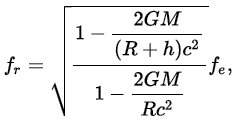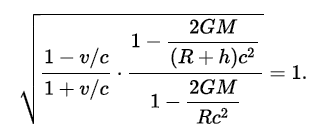慕容青草的博客
哲學園地戴榕菁
1. 背景
去年底我在academia.edu討論時間的意義以及為什麽引力不可能如廣義相對論所說的那樣改變時間速率的時候,有一位名為Степан Тигунцев的人在那裏發表了與Pound-Rebka實驗有關的評論,引起了我對那個實驗的注意。那是一個在哈菲爾-基廷實驗之前的另一個被稱為驗證了所謂的相對論時間效應的著名的經典實驗。今年初我去維基百科查了一下那個實驗並打印了當時的網頁內容(見附錄),從那裏我了解到Pound-Rebka實驗的基本內容以及為什麽會被認為是驗證了相對論的時間效應。當時該網頁的更新日期為2022年7月5日。通常來說,維基百科的網頁更新的越不頻繁就表明相關網頁的內容比較沒有爭議。
Pound-Rebka實驗是從一個塔頂向地麵的一個接收裝置發射光束,發射器內的電子受激態振動頻率被選為與接受裝置裏的相同,因此按照愛因斯坦-普朗克的光能公式,如果光束的光子能被接收裝置吸收,就表明光子到達接收裝置時的頻率與光子被發出時的頻率一致(不一定完全一樣,但是在一定的誤差範圍內)。Pound和Rebka兩個人就讓發射器向上運動從而產生紅移效應,這樣的話,如果在某個紅移點上光子最終被下麵等著的接收裝置吸收了,就表明光束在向下傳播的過程中經曆了藍移效應從而使得藍移與紅移相互抵消了。
從上麵的描述我們可以看出Pound-Rebka實驗實際上比較靠譜地驗證了這樣兩件事:1)光子在地球引力場中向下運動時產生了藍移;2)根據愛因斯坦-普朗克的光能公式,光子在地球引力場中的向下運動使得光子的能量增加。
相對論學者以其向來奇葩的邏輯愣是得出結論說Pound-Rebka實驗證明了廣義相對論關於引力導致時間變慢的結論,並給這種現象起名為引力紅移,這種紅移說的不是引力讓光線產生紅移而是引力讓時間變慢。
但實際上,即便是用牛頓定律,隻要認為光子有質量,我們同樣可以得出引力可以使得向下運動的光子的能量增加的結論;也就是說隻要承認愛因斯坦-普朗克公式並承認光子有質量,用牛頓定律也可得出引力讓光線發生藍移的結論。因此,別人同樣可以說Pound-Rebka實驗是驗證了光子有質量,同時也證明了光子在重力作用下做了加速運動。當然,相對論學者們不會這樣認為。
那麽相對論學者是用什麽樣的邏輯來得出Pound-Rebka實驗驗證引力讓時間變慢的結論的呢?
首先,他們說Pound-Rebka實驗驗證了廣義相對論所說的引力讓光線發生藍移,也就是說頻率變大波長變短。
從牛頓定律的角度出發,這可以用單純的波動物理特性的變化來解釋。但是,相對論學者是不承認光子有質量的,因此他們不承認光子可能受到任何由質量引起的作用力的;他們非常奇葩地把光子頻率之所以會變大的原因解釋為時間變慢了。也就是說原來1秒鍾變成了現在的0.9秒鍾,因而原來每1秒鍾變1000次的周期變化,現在成了每0.9秒鍾變1000次的周期變化,所以頻率就增加了。也就是說,廣義相對論學者認為Pound-Rebka實驗表明的光子的能量的增加不是因為光子如同伽利略從匹薩塔上丟下的鐵球那樣受到了重力的吸引,而是因為地球引力改變了時間的速率。。。。對於一般人來說,這個圈子繞的有點大,但對於相對論學者來說這就是他們可以心安理得地接受的邏輯。
當然,相對論學者要想得出上述結論還需要一個對他們來說是至關重要的的法寶,但同時也是他們的致命的照門,就是那個連愛因斯坦本人都猶豫不決的真空中的光速在引力場中不變的前提假設。這是因為如果光速不是不變的,那麽由下式(其中f 是頻率,λ是波長,而c是光速):
f = c/ λ (1)
我們可以知道如果波長保持不變,隻要光速上升,頻率也可以增大。也就是說隻要光子以更快的速度走完同樣的距離的話,它的頻率也照樣可以上升。但按照相對論的光速不變的前提,則隻有當波長變短時頻率才會增大,而波長與周期之間又有著下麵的關係:
λ = cT (2)
T是周期。這樣一來,在c不變的前提下,隻要把原本作為運動之物理參數的周期T的變化解釋為時間的變化,就可以得出波長變短的結論,然後由(1)就可得出頻率變長的結論。(這裏的波長變短不是按照洛倫茲的動尺變短的套路來的。這裏強調的是引力引起的時間變化而不是速度產生的長度變化,這裏如果用洛倫茲變換的話就會出現無限大的洛倫茲因子的問題。)而他們用來把振動周期變化解釋為時間變化的邏輯為:不是光子的周期改變導致時間改變,而是當所有的時間都改變時,周期也就改變了,而且因為時間均勻地發生了變化,所以振動周期仍然是振動周期,隻不過周期的長短隨時間的變化而變了。
可見,相對論學者之所以會認為Pound-Rebka實驗驗證了所謂引力導致時間變慢是以他們的一整套理論為前提的,而不是簡單直接的邏輯結論。
2. 他們的變化
當我去年已經用大量的證據論證了真空中的光速不可能如狹義相對論假設的那樣對所有的觀察者都是一樣的(參見【[i]】)之後,我就知道沒有理由認為光速在引力場中一定是不變的,而愛因斯坦本人對於引力場的光速不變假設都出現了自相矛盾的前後搖擺不定的言論更是讓我相信假設光速在引力場中不變是沒道理的。在光速不是不變的前提下,由上述的討論可以直接推翻所謂的Pound-Rebka實驗驗證了引力場導致時間變慢的結論;尤其是在我已經通過討論時間的意義(【[ii]】,【[iii]】)來論證了引力和速度都不可能導致時間變化之後,我更是肯定可以輕易地駁倒相對論學者們關於Pound-Rebka實驗的結論,隻是等待有時間和精力的機會而已。
不久前當我開始推翻那個所謂的一次性驗證狹義和廣義相對論的哈菲爾-基廷實驗時(參見【[iv]】),就打算要在解決了哈菲爾-基廷實驗之後,就來解決這個Pound-Rebka實驗。但是,當我再次回到今年初查看該實驗的相同網頁【[v]】時,卻發現他們改了。更確切地說,有人對該網頁的內容做了大幅修改。特別是增加了下麵這段話:
【
The equivalence principle (EP) lies at the heart of the general theory of relativity. Most proposed alternatives to general relativity predict violation of the EP at some level. The EP includes three hypotheses:
- Universality of free fall (UFF). This asserts that the acceleration of bodies freely falling bodies in a gravitational field is independent of their compositions.
- Local Lorentz invariance (LLI). This asserts that the outcome of a local experiment is independent of the velocity and orientation of the apparatus.
- Local position invariance (LPI). This asserts that clock rates are independent of their spacetime positions. Measurements of differences in the elapsed time displayed by two clocks will depend on their relative positioning in a gravitational field. But the clocks themselves are unaffected by gravitational potential.
Gravitational redshift measurements provide a direct measure of LPI. Of the three hypotheses underlying the equivalence principle, LPI has been by far the least accurately determined.
】
如同有關相對論的文章經常出現的別扭情景一樣,這麵這段話的最後兩句在邏輯上是針尖對麥芒的,隻是不了解狀況的人不容易看出而已。前一句話“Gravitational redshift measurements provide a direct measure of LPI.”聽上去象是對廣義相對論的肯定,而且還是實驗性的肯定,那可是了不起的肯定。但接下來的第二句話“Of the three hypotheses underlying the equivalence principle, LPI has been by far the least accurately determined.”馬上就打臉那第一句話。這是因為上麵的第3條對LPI的解釋為:“時鍾的節奏獨立於時空中的位置。對於由兩個時鍾的讀數顯示出來的時間差依賴於他們在引力場中的位置。但是時鍾他們自己不受引力勢能的影響。”而“Of the three hypotheses underlying the equivalence principle, LPI has been by far the least accurately determined.”這句話則說上麵的第3條還沒有被精確地確定。
不誇張地說,上麵這第二句甚至可以被看成是用不情願的口吻在不過分違背他們的政治正確的前提下以保守的形式來表達了我從去年開始反複強調的論點:所謂的引力改變時間的實驗如果沒有數據上的造假,那就是引力改變了時鍾的周期節奏,而不是引力改變了時間。
特別是他們在前麵還說了這樣一句對於他們來說幾乎是大逆不道的話:
【
In the decade preceding Einstein's publication of the definitive version of his theory of general relativity, he anticipated several of the results of his final theory with heuristic arguments, not all of which were to prove to be correct.
】
這讓我頓時有了一種“他們似乎已經被我說服了,這個世道改變了”的感覺。當然,我馬上就冷靜地告誡自己:世界還未改變,自己尚需努力。
不過,既然他們的語調都變了,我也可以先稍微省點力了。這篇本來應會更長得多的文章,就到此為止吧。給他們點時間,看看世界會如何變化。。。。。。
。。。。。。
結束語
其實Pound-Rebka實驗中的光子發射器並非簡單地做向上的運動而是做上下來回的振動。因此其所產生的光線對於下方的物體來說,既有紅移也有藍移的,隻不過人們不認為在引力場中向下運動的光線會產生紅移而已,所以由光源產生的藍移就被忽略了。。。。從這點上說,這裏所謂的驗證藍移的邏輯是有瑕疵的,因為他們是在實驗還沒有進行之前就已經確定了向下的光線隻能藍移不會紅移。假如明天有人愣是提出一個奇葩的理論說光線在引力場中向下運動會產生紅移,並給出一個相應的奇葩計算公式來,他也可以用Pound-Rebka的實驗數據來作為驗證他們的光子在引力場中向下運動產生紅移的證據。。。。那麽是否存在提出這種奇葩理論的可能性呢?還真的存在。。。。這是因為按照潮汐力(tidal force)理論,一個物體朝向引力源運動時,它會被潮汐力拉長,如果有人把這個理論應用與光子,他也可以說光子的波長在向地球運動過程中會變長而不是變短,這時如果假設光速不變,則可以得出光子向地球的運動中是紅移而不是藍移的結論。。。。當然,我是不會認同這樣的結論的,因為這意味著光子向地球運動的過程中不但沒有從地球勢能中獲取能量還被地球吸走了能量。但是,考慮到現代物理學中有很多結論都是超出人們已有的認知的,從邏輯上說確實可以有人用上述這種光子紅移的奇葩理論來將Pound-Rebka實驗解釋為驗證了他們的理論。。。。我這裏指出這一點隻是要說明Pound-Rebka實驗的設計邏輯其實是有缺陷的。雖然你可以說依據牛頓定律還是依據廣義相對論人們都不會接受在引力場中向下運動的光線會產生紅移,但這同時也意味著Pound-Rebka實驗顯得是多餘的,因為你沒有做實驗之前就已知了結果,而且可以對實驗結果做相反解釋的結論已經是不需要實驗就被排除在外了。
不管怎麽說,從去年開始,至此我已推翻了下述幾個實驗對相對論的所謂驗證:Sagnac實驗,大氣中的µ介子測量實驗,哈菲爾-基廷實驗,Pound-Rebka實驗,以及之前的MM實驗。同時也提出了對於馬裏蘭大學和NIST所謂的重複哈菲爾-基廷實驗的嚴重質疑,並指出假如那個大名鼎鼎的NIST沒有在他們的實驗中作假,那麽他們的所謂驗證引力的時間效應的實驗隻能證明引力可以影響他們的原子鍾的節奏而不是時間的節奏。我對NIST的質疑的前提是基於對馬裏蘭大學的實驗的質疑的前提之下的,而我對馬裏蘭大學實驗的質疑的前提是他們的實驗得出的慣性影響結果怎麽會和哈菲爾-基廷在(即便是按照狹義相對論都)完全錯誤的理論框架下估算出的結果的平均值一致,而他們的引力影響怎麽會和不小心忽略了哈菲爾-基廷報告上的小黑點的(且是以民航公司提供的極粗糙的原始數據來計算的)結果之平均值一致,再加上他們用地麵打到飛機上再反射的激光來測量飛機的所謂時間變慢之荒唐。另外,網絡牛人dialect的係列視頻【[6],[7],[8],[9],[10]】也可幫助我來反駁市麵上所有的所謂論證孿生子悖論不是悖論的言論。
附錄. 2023年初打印的2022年7月版的維基百科關於Pound-Rebka實驗的介紹
Pound–Rebka experiment
The Pound–Rebka experiment was an experiment in which gamma rays were emitted from the top of a tower and measured by a receiver at the bottom of the tower. The purpose of the experiment was to test Albert Einstein's theory of general relativity by showing that photons gain energy when traveling toward a gravitational source (the Earth). It was proposed by Robert Pound and his graduate student Glen A. Rebka Jr. in1959, and was the last of the classical tests of general relativity to be verified (in the same year). It is a gravitational redshift experiment, which measures the change of frequency of light moving in a gravitational field. In this experiment, the frequency shift was a blueshift toward a higher frequency. Equivalently, the test demonstrated the general relativity prediction that clocks should run at different rates in different places of a gravitational field. It is considered to be the experiment that ushered in an era of precision tests of general relativity.
Overview
Consider an electron bound to an atom in an excited state. As the electron undergoes a transition from the excited state to a lower energy state it will emit a photon with a frequency corresponding to the difference in energy between the excited state and the lower energy state. The reverse process will also occur: if the electron is in the lower energy state then it can undergo a transition to the excited state by absorbing a photon at the resonant frequency for this transition. In practice the photon frequency is not required to be at exactly the resonant frequency, but must be in a narrow range off requencies centred on the resonant frequency: a photon with a frequency outside this region cannot excite the electron to a higher energy state. Now consider two copies of this electron-atom system, one in the excited state (the emitter), the other in the lower energy state (the receiver). If the two systems are stationary relative to one another and the space between them is flat (i.e. we neglect gravitational fields) then the photon emitted by the emitter can be absorbed by the electron in the receiver. However, if the two systems are in a gravitational field then the photon may undergo gravitational redshift as it travels from the first system to the second, causing the photon frequency observed by the receiver to be different to the frequency observed by the emitter when it was originally emitted. Another possible source of redshift is the Doppler effect: if the two systems are not stationary relative to one another then the photon frequency will be modified by the relative speed between them. In the Pound–Rebka experiment, the emitter was placed at the top of a tower with the receiver at the bottom. General relativity predicts that the gravitational field of the Earth will cause a photon emitted downwards (towards the Earth) to be blueshifted (i.e. its frequency will increase) according to the formula:

where fr and fe are the frequencies of the receiver and emitter, h is the distance between the receiver and emitter, M is the Earth's mass, R is the radius of the Earth, G is Newton's constant and c is the speed of light. To counteract the effect of gravitational blueshift, the emitter was moved upwards(away from the receiver) causing the photon frequency to be redshifted, according to the Doppler shift formula:

where v is the relative speed between the emitter and receiver. Pound and Rebka varied the relative speed v so that the Doppler redshift exactly cancelled the gravitational blueshift:

In the case of the Pound–Rebka experiment h ? R; the height of the tower is tiny compared to theradius of the earth, and the gravitational field can be approximated as constant. Therefore, the Newtonian equation can be used:

The energy associated with gravitational redshift over a distance of 22.5 meters is very small. The fractional change in energy is given by δE/E, is equal to gh/c2 = 2.5×10−15. As such, short wave length high energy photons are required to detect such minute differences. The 14 keV gamma rays emitted by iron-57 when it transitions to its base state proved to be sufficient for this experiment.
Normally, when an atom emits or absorbs a photon, it also moves (recoils) a little, which takes away some energy from the photon due to the principle of conservation of momentum. The Doppler shift required to compensate for this recoil effect would be much larger (about 5 orders of magnitude) than the Doppler shift required to offset the gravitational redshift. But in 1958 Rudolf Mössbauer reported that all atoms in a solid lattice absorb the recoil energy when a single atom in the lattice emits a gamma ray. Therefore, the emitting atom will move very little (just as a cannon will not produce a large recoil when it is braced, e.g. with sandbags). This allowed Pound and Rebka to set up their experiment as a variation of Mössbauer spectroscopy.
The test was carried out at Harvard University's Jefferson laboratory. A solid sample containing iron(57Fe) emitting gamma rays was placed in the center of a loudspeaker cone which was placed near the roof of the building. Another sample containing 57Fe was placed in the basement. The distance between this source and absorber was 22.5 meters (73.8 ft). The gamma rays traveled through a Mylar bag filled with helium to minimize scattering of the gamma rays. A scintillation counter was placed below the receiving 57Fe sample to detect the gamma rays that were not absorbed by the receiving sample. By vibrating the speaker cone the gamma ray source moved with varying speed, thus creating varying Doppler shifts. When the Doppler shift canceled out the gravitational blueshift, the receiving sample absorbed gamma rays and the number of gamma rays detected by the scintillation counter dropped accordingly. The variation in absorption could be correlated with the phase of the speaker vibration, hence with the speed of the emitting sample and therefore the Doppler shift. To compensate for possible systematic errors, Pound and Rebka varied the speaker frequency between10 Hz and 50 Hz, interchanged the source and absorber-detector, and used different speakers(ferroelectric and moving coil magnetic transducer). The reason for exchanging the positions of the source and the detector is doubling the effect. Pound subtracted two experimental results:
1. the frequency shift with the source at the top of the tower
2. the frequency shift with the source at the bottom of the tower
The frequency shift for the two cases has the same magnitude but opposing signs. When subtracting the results, Pound and Rebka obtained a result twice as big as for the one-way experiment. The result confirmed that the predictions of general relativity were borne out at the 10% level. This was later improved to better than the 1% level by Pound and Snider.
Another test, Gravity Probe A, involving a space-borne hydrogen maser increased the accuracy of the measurement to about 10−4 (0.01%).
This page was last edited on 25 July 2022, at 05:27
(UTC)
注:上述內容是在2023年初於文獻【3】完全相同的地址打印下來的。
[[1]] 戴榕菁(2023)當哲學被藐視之後。。。。(更新版)
[[2]] 戴榕菁(2022)時間的意義
[[3]] Dai, R. (2022) “What Is Time?”. Retrieved from: https://www.researchgate.net/publication/366723983_What_Is_Time.
[[4]] 戴榕菁(2023)真相或許比想象的更。。。。
[[5]] Wikipedia, “Pound–Rebka experiment”. Retrieved from: https://en.wikipedia.org/wiki/Pound%E2%80%93Rebka_experiment. Last edited on 28 August 2023, at 03:34 (UTC).
[[6]] Dialect (2019). [YouTube] “Why Solutions to the Twin Paradox are WRONG” [video] url: https://www.youtube.com/watch?v=nRuVGOm7560
[[7]] Dialect (2018). [YouTube] “Solutions to the Twin Paradox are STILL Wrong” [video] url: https://www.youtube.com/watch?v=FGoAZKyI6ZY
[[8]] Dialect (2021). [YouTube] “Einstein, Gravity, and the Twin Paradox (Einstein's 1918 Solution) ”. [video] url: https://www.youtube.com/watch?v=cccuzND_LoQ
[[9]] Dialect (2021). [YouTube] “Do Inertial Frames Resolve The Twin Paradox? ”. [video] url: https://www.youtube.com/watch?v=y0OI1IFLXGk
[[10]] Dialect (2021). [YouTube] “Even More Paradoxical: The Twin Paradox in Curved Spacetime”. [video] url: https://www.youtube.com/watch?v=9KG-S93uG5g




